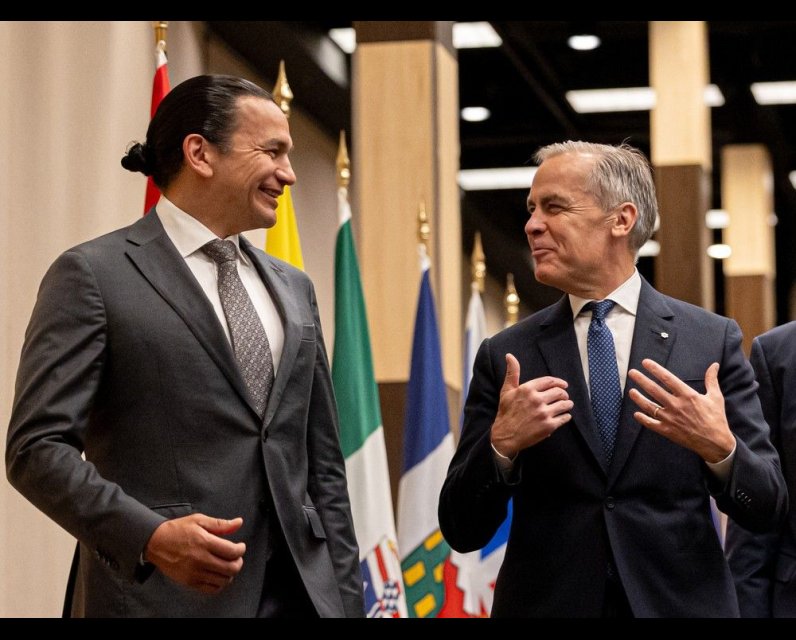After the Port of Churchill, Manitoba premier is eyeing another major project going north

OTTAWA — Now that the expansion of the Port of Churchill in northern Manitoba is likely to be among the federal government’s list of nation-building projects , Manitoba Premier Wab Kinew is confident the venture could pave the way for another one of his top priorities.
The Kivalliq Hydro-Fibre Link, an Inuit-led project, proposes a 1,200 kilometre transmission line connecting Manitoba’s grid to five communities in southwestern Nunavut — providing them with renewable energy to reduce reliance on diesel and bringing reliable internet.
Kinew told the National Post he believes the project — which would be Nunavut’s first land-based infrastructure link to southern Canada — can still make it on Ottawa’s list of nation-building projects. The first projects are set to be announced within two weeks.
“We want to build big things in this country,” Kinew said earlier this week. “How about we build a corridor that connects Western Canadian resources to international tidewater in Hudson Bay, and then we spur north from there and light up the territory to our north?”
“I think the long story short is that we can pursue both of those opportunities,” he added.
Kinew has put much of his political weight behind the initiative in the past months, ordering Manitoba Hydro in April to set aside 50 megawatts of power from expiring export contracts towards the development of the hydro-fibre link between Churchill and Nunavut.
Kinew also signed a joint statement with his Nunavut counterpart, P.J. Akeeagok , declaring their commitment to advance the project connecting their two regions.
Kinew and Akeeagok both put the Kivalliq Hydro-Fibre Link high on their list of priorities when they met with Prime Minister Mark Carney in Saskatoon back in June. The federal government has vowed to come up with a small list of executable projects.
On paper, the hydro-fibre link project meets the criteria set forth in the Building Canada Act. Its proponents say it will strengthen Canada’s autonomy, provide economic benefits to the country, advance the interest of Indigenous peoples and address the climate crisis.
“If we have the opportunity to light up the North, including some communities in northern Manitoba that are still running on generators, to me, that’s a climate win alongside an economic win,” said Kinew, adding that he was “still engaging on a lot of the details.”
In addition, it is expected to have a quick turnaround, with construction set to start in 2028 and the transmission line is expected to be fully functional by 2032, according to Anne-Raphaëlle Audouin, the CEO of Nukik Corporation which oversees the project.
The federal government is no stranger to the project, having already spent millions for the development stages and environmental fieldwork for it to move forward.
Since 2021, Kivalliq Hydro-Fibre Link has been mentioned in three consecutive federal budgets, has been consistently recommended for federal support by the House of Commons finance committee, and has been mentioned in different reports, said Audouin.
However, she admits that the project is expensive, with a price tag now estimated at more than $3 billion. While it has the support of the Canada Infrastructure Bank, which would fund part of the project, the rest of the funding — private equity and tax credits — is still uncertain.
Audouin said “everything’s pointing to the fact” that the hydro-fibre link project could end up on the government’s major projects list and expressed hope it would help secure the rest of the financing.
“Being on that list would probably actually attract capital because now you’ve got the backing of the federal government identifying you as a project that’s worthy of proceeding. If anything, it props you up as a project,” said Audouin in a recent interview.
“Until they release the list, it’s anybody’s guess,” she said.
Speaking in Berlin on Wednesday, Natural Resources Minister Tim Hodgson said the government’s new major projects office — which will be the main point of contact to help fast-track those priority initiatives — will be launched by the end of the week.
“Today is Wednesday, so it’ll either be Thursday or Friday,” he said in a press conference.
Hodgson, however, declined to say who would oversee this office and if the government already has a list of major projects ready to go. The Privy Council Office (PCO) also did not respond to the National Post’s questions on appointments and the list as of deadline.
Carney revealed during his travels to Europe this week that his government would be formally announcing investments with respect to new port infrastructure in the next two weeks — notably the expansion of the Port of Montreal and the Port of Churchill.
Carney specifically singled out the Port of Churchill, which he said could “potentially” unlock pathways to ship liquified natural gas and critical minerals to Europe. Kinew said his phone “blew up” as soon as the prime minister mentioned the project on Tuesday.
Conservative Leader Pierre Poilievre said he was “glad” that Carney had noticed his proposal to develop the Port of Churchill, more than three years after he proposed it, but expressed skepticism that this expansion project would actually see the light of day.
“What I find incredible is that he has been in power for 170 days and not only is there not a single shovel in the ground on any of these projects, there are not even firm proposals for these projects,” said Poilievre, who was speaking from Charlottetown, P.E.I.
“It’s more Liberal show business rather than getting it done.”
National Post calevesque@postmedia.com
Our website is the place for the latest breaking news, exclusive scoops, longreads and provocative commentary. Please bookmark nationalpost.com and sign up for our newsletters here.

Comments
Be the first to comment